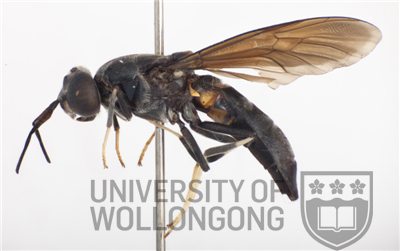Taxonomy
Family: Stratiomyidae
Subfamily: Hermetiinae
Genus: Hermetia Latreille 1804
Species: illucens Linnaeus 1758
Biology
Hermetia illucens, also known as the black soldier fly, can reach up to 20mm in length and is almost worldwide in distribution. This species has been associated with both surface and buried human remains in the United States, and is most active during the advanced stages of decomposition when the carcass is relatively dry (see Lord et al. (1994)).
Distribution
Hermetia illucens originates from the Americas, and was probably introduced into Australia by the importation of decaying plant material (Callan 1974). It is now well established throughout Australia, and has been recorded from all states except South Australia, although it almost certainly exists there too. Although the authenticity of the Tasmanian record is questionable, this represents the southern-most occurrence of this species globally (Callan 1974).
Relevant Literature
Callan, E.M. (1974) Hermetia illucens
(L.) (Dipt., Stratiomyidae), a cosmopolitan
American species long established
in Australia and New Zealand. Entomologst's
Monthly Magazine 109,
232-234.
Lord, W.D., Goff, M.L., Adkins, T.R. and Haskell,
N.H. (1994) The black soldier fly Hermetia illucens
(Diptera:
Stratiomyidae) as a potential measure of human postmortem
interval: observations and case histories. Journal of Forensic
Sciences 39,
215-222.
May, B.M. (1961) The occurrence in New Zealand and
the life-history of
the soldier fly Hermetia
illucens (L.) (Diptera:
Stratiomyiidae). New
Zealand Journal of Science 4, 55-65.
Tomberlin, J.K., Sheppard, D.C. and Joyce, J.A. (2002) Selected life-history traits of black soldier flies (Diptera: Stratiomyidae) reared on three artificial diets. Annals of the Entomological Society of America 95, 379-386.


